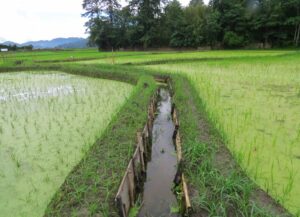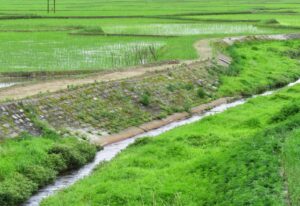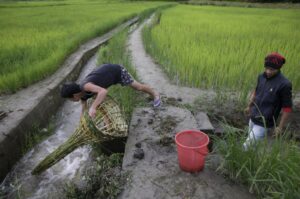
The Apatani Tribe with a population of 25,000 lives on the Ziro Plateau located at an elevation of 1,572 meters from the sea level, in the lower Subansiri district of Arunachal Pradesh. This plateau lies between the Kamala, Khru and Panior ranges in the Eastern Himalayas. The average rainfall here is about 1,758 millimeters, 75 percent of which falls between the months of May and September. The driest months are March and April. Water is available from the Kele River and streams and springs that flows into it.
The Apatani follow a traditional form of rice cultivation, the knowledge of which has been passed down from generation to generation. Using natural gradients and contours to prepare and cultivate the fields and irrigate them, this is a unique farming system, covering approximately 30 sq kms of area in the gently sloping valleys of the mountainous region. The largest areas under cultivation are found in the villages of Hong, Siro and old Ziro.

The primary crops grown here are rice, millet, and maize. Bamboo and pine are planted around the fields. The fields are separated by 0.6 m high earthen dams supported by bamboo frames. These dams serve to hold water and soil in the fields. Millet is grown on these dams in order to strengthen them, as well as on dry hill slopes.

Amo and Mipa are the traditional varieties of rice cultivated by the Apatani. Since the fields are located in valleys, the soil remains fertile due to the nutrient wash out from the hill slopes. Fertility is maintained due to the manure which is available from the waste occurring from the pisiculture which is practised in the rice fields, and from the manure of domestic animals. Refuge from homesteads is also used. In fact channels leading to the fields carry refuse along with rain water from the habitation to the fields.

The rice fields are irrigated by an intricate system of channels and ducts which carry water from a series of streams that flow into the Kele River. Water from the river is also used for irrigation. The irrigation system depends upon streams that originate in the mountains and join the river that flows through the plateau. The life of these springs and streams is closely dependent upon the health of the catchment from where they originate. The catchment has a good forest cover which has until now been preserved by the community.

Water is distributed through a management system that ensures irrigation equitably to fields located in the upstream and downstream areas. After the upper fields receive their share of water, the outlet channel is opened so that the next series of fields receive water. This method is followed until the last filed is reached. However, in this process, it takes some time for the water to reach the tail end. During this time the lower fields have to remain without water. To overcome this problem, a separate channel at the head is made from the main stream through which water is diverted to fields located at the tail end. The place where the channel separates is called a borang. The community takes collective responsibility to maintain the systems, and women contribute most of the labour required for maintaining the channels.

In the 1950s, when the agriculture department of the state government began to encourage the rice farmers to stock fish in special ponds, farmers thought it would be better to raise fish in their fields instead. This led to an innovation in fish-rice farming that is now being followed extensively by the Apatani.
The Apatani system of rice cultivation is not found anywhere esle in the world. Research has proved that the sytem is highly efficient and helps to preserve the ecosystem in which it is practiced. The farming system is still organic in nature and has not yet been influenced by modern farming techniques and the introduction of chemical fertilizers and pesticides. The preservation of the biodiversity in the area is closely linked with the practice of the Apatani rice farming system.
The system is currently under threat from various sources. There have been many instances when loggers have tried to gain access to forests which form the catchment of the irrigation system. In recent times, the growing township of Hapoli located in the Apatani plateau is posing a threat to the traditional system of irrigation. The town’s sewage is being emptied into the river that irrigates the rice fields.
Recently hybrid varieties of rice have been introduced in the area. With the introduction of hybrid varieties, it is likely that pesticides may also be introduced. New varities needs to be introduced systematically and gradually and monitored very carefully so that the organic nature of the traditional cultivation is preserved. Just like the adaptation of the pisicultur, introduction of any new elements into their farming system should become a process of evolution that does not destroy the original nature of system.
Source
Springs of Life: India’s Water Resources By Ganesh Pangare, Vasudha Pangare, Binayak Das
http://www.jeffbauche.com/projects/apatanis-stolen-beauties/
https://redscarabtravelandmedia.wordpress.com/tag/abasa-homestay/
http://anupamfolkrice.blogspot.in/2014_06_01_archive.html
http://www.downtoearth.org.in/gallery/the-hidden-valley-56050


